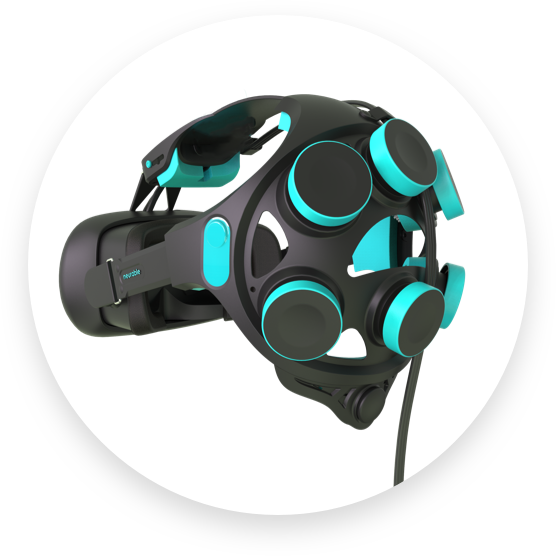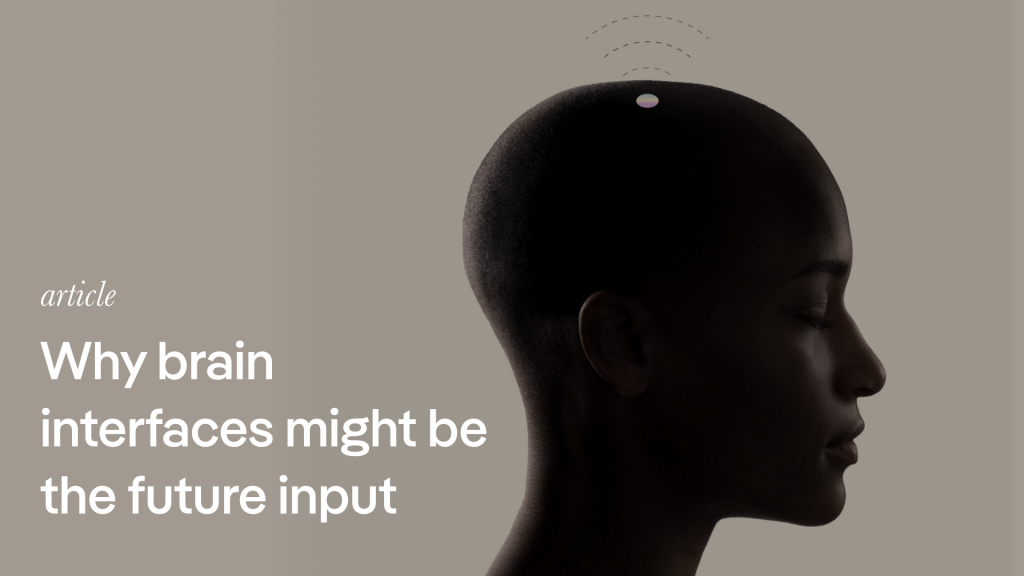Designing for the next generation.

The human brain is incredible. It has around 100 billion neural connections and can process billions of bits of information every second. It’s an extraordinary piece of organic technology whose abilities can be even more significantly expanded thanks to brain interfaces. In the near future, brain interfaces may very well become a major input method.
How Brain Interfaces Work
A brain interface allows someone to interact with a computer by using their brain activity. Neurons within the brain are connected by dendrites and axons. Whenever we have a thought, physically move, feel something, or remember, neurons are firing away. Electric signals shoot out from one neuron to the next at a blazingly fast 250 MPH. Signals get generated thanks to differences in electric potential that ions on neuron membranes carry. Paths that signals take are insulated by the myelin sheath, although part of the signal bleeds through. Scientists can detect this and interpret the meaning and then use it. The opposite is true as well, which allows for seemingly-miraculous feats like blind people seeing again.
Opportunities Brain Interfaces Provide
Elon Musk has stated that brain interfaces are necessary to ensure the human race maintains its supremacy over artificial intelligence. The man who famously said, when speaking of AI, “If you can’t beat them, join them.” believes we could become the slaves of AI if we don’t maintain the ability to be more advanced than them. A brain interface will intertwine organic reality with synthetic reality, allowing humans to keep AI in check, or at least that’s the theory. Musk’s Neuralink will be an incredibly fast high-bandwidth brain interface that will lead to a merging of the human brain with AI.
Neuralink approach is to implant a link — sealed, implanted device that processes, stimulates, and transmits neural signals
Micron-scale threads are inserted into areas of the brain that control movement. Each thread contains many electrodes and connects them to an implant, the Link.
Another promising company called Neurable claims it can interpret human intent, measure emotions, and allow for telekinetic control of virtual reality. In fact, this is the company that created the very first brain-controlled VR game. Unlike Neuralink’s neural lacing, Neurable uses an EEG headset. This is how most brain interfaces work today, since EEGs measure the electric fields around the human brain. So, no implantation, just a simple headset.

Neurable’s devices are non-invasive, quick to set up, and easy to use. Our DK1 is a VR-compatible brain-sensing device with 6 dry EEG sensors. It has >90% correlation with wet EEG systems and includes continuous impedance and signal quality monitoring.
Our software is also compatible with any Wearable Sensing device (or any EEG system that streams data using LSL).
Our software tools enable easy integration with Unity, C++, and C# environments. We also offer data export capabilities and a web portal for 3D data visualization and post-session analysis.
The Future of Brain Interfaces
Brain interfaces are still in their infancy. While Neuralink recently unveiled its working prototype surgically implanted in a pig’s brain, it didn’t show off anything that jaw-dropping. The future of brain interfaces, however, can be extraordinary because we just started to explore this technology.
Here’s what will be possible with this technology:
- Thoughts will be transmitted to a computer interface as images.
- Treatment of disorders and diseases like dementia, epilepsy, paralysis, and others.
- Synthetic digital telepathy with others using brain interfaces
- Connect to, and use, the internet
- Recording your dreams
- Recover lost memories
- Controlling prosthetic limbs
Brain interfaces can also be used by everyday people to boost their productivity. A company called Neurosity has developed brain interface products that can do just that. Basically, this brain interface will know exactly when you’re “in the zone” and work its magic to keep you there. For example, when you’re in peak performance mode, you can automatically mute notifications so that you have fewer distractions. It also has an app called Notion that lets you stream the exact type of music that will sync up with your brain to increase your productivity.
How UX Design Producer Designs Can Use Brain Interfaces
When we are designing a digital product we are thinking about the input (what the user inserts) and about the output (what the product or system provides). The input influences the output, if the input is not accurate, the output will not be exact either. During the last decade we explored other input ways than the usual click, tap, and typing:

We needed to realize that the input is still not 100% accurate which causes a lot of mistakes. That might be different for surprisingly accurate brain interfaces.
Challenges Facing Brain Interfaces
Brain interfaces are not without their challenges. Most projects right now have proprietary source code that is closed off from prying eyes. Open source code can relieve concerns about potential ‘bad actors’ or companies installing backdoors and other malware that may spy on people or worse.
There are ethical challenges that will come up, mostly in terms of privacy and safety. How invasive is too invasive? How much peering into brains is too much? The future is going to be a complex one, but it will also be incredibly exciting and full of opportunities.



